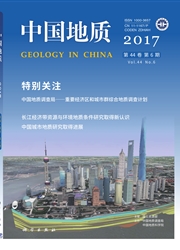

 中文摘要:
中文摘要:
南极中山站区(拉斯曼丘陵)高级片麻岩中多发育蠕英石即斜长石+石英,蠕英石的出现表明岩石中往往同时存在斜长石和钾长石。通常还有一些相关现象与蠕英石相伴,如矿物颗粒周围的斜长石±石英边、钾长石边。蠕英斜长石比主斜长石牌号更高和更低的现象均可发生.而且蠕英斜长石的成分比主斜长石变化范围更大。蠕英石的形成主要涉及长英质矿物的变化.不仅涉及到钾长石的分解。可能还与钾长石的出溶、石英、黑云母的分解,甚至斜长石的出溶和分解有关。析出的组分对先存矿物(主要是钾长石)溶蚀和交代,同时出现蠕英石。变形有利于蠕英石的形成,但不是必要条件。长英质岩石中蠕英石的形成意味着降压过程的发生。形成蠕英石的组分主要源于体系自身,而不是外部环境。结合与相关结构的对比和分析,蠕英石的产生主要是长英质组分晚期分异的结果:由于K,Na(Ca)的分异,Na(Ca)^(2)+沉淀,K^+组分活动,SiO2亦可有一定的迁移;释放、迁移的组分更偏碱性。这种分异是岩石内部的成分和结构调整的产物。但相关组分活动的空间非常有限,一般限于若干个矿物颗粒的尺度。蠕英斜长石的形成可能代表着斜长石-石英之间的一种共结,并对新生斜长石的成分起到一种缓冲作用.其过程更接近溶液而不是岩浆性质。同时表示除H2O外各种组分活动的基本结束。
 英文摘要:
英文摘要:
Myrmekite is commonly developed in the high-grade gneisses of the Chinese Antarctic Zhongshan Station area (Larsemann Hills). The occurrence of myrmekite is mually the symbol of the association of plagioclase and K-feldspar. Some plagioclase-quartz rims and K-feldspar rims along mineral grains are generally related to the texture. The anorthite content of the plagioclase in myrmekite may be lower or higher than the content of the main plagioclase in the rock, and the former shows a wider composition range than the latter. The origin of myrmekite is mainly related to the change of felsic minerals. Others factors like the decomposition and exsolution of K-feldspar, decomposition of quartz and biotite and even decomposition and exsolution of plagioclase sometimes may be involved. The exsolved components corrode and replace the preexisting minerals (predominandy K-feldspar) and myrmekite is produced simultaneously. Although not a necessary condition, deformation is favorable for the formation of myrmekite. The formation of myrmekite in felsic rocks also implies the decompression process in PT evolution. The components responsible for the formation of myrmekite were mainly derived from the system itself, rather than from the outside environment. In combination with its correlation with related textures and analysis, the formation of myrmekite is the result of differentiation of felsic components in the late stage: the differentiation of K and Na (Ca) resulted in the precipitation of Na (Ca)^(2)+ and mobilization of K^+ as well as migration of SiO2 to some degree. The released and migrating components tend to be more alkaline. This differentiation is the result of adjustment of the composition and textures inside the rocks, but the activity of the components is confined to the scale of several grains. The presence of myrmekite may represent cotectic crystallization between plagioclase and quartz and exerts a buffering effect on the composition of neogenic plagioclase. The process approaches th
 同期刊论文项目
同期刊论文项目
 同项目期刊论文
同项目期刊论文
 期刊信息
期刊信息
